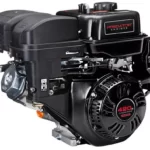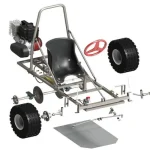Go-kart racing continues to captivate fans across the globe as it evolves from a family-friendly activity into competitive motorsport enjoyed by people of all ages. A key factor that plays a significant role in a go-kart’s performance is its weight. This article will examine the various types of karts and the factors contributing to their weight. We will thoroughly understand the average go-kart weight and its importance in the exciting karting world.
Understanding the importance of weight in go-kart racing is crucial for racers, hobbyists, and anyone who appreciates the complexities of this thrilling motorsport. The weight of a go-kart can impact factors such as speed, handling, and acceleration, which can significantly influence a driver’s success on the track.
Additionally, being familiar with the weight of different go-karts can be helpful when it comes to choosing the right kart for your needs, whether it’s a recreational model for weekend fun or a competitive kart designed for serious racing.
Go-Kart Types and Categories
Go-karts come in various shapes and sizes, each designed for a specific purpose or level of competition. To better understand the average go-kart weight, it’s essential to familiarize yourself with the main types and categories of go-karts.
Recreational go-karts
Recreational go-karts are typically built for casual driving and family fun, and they can be found at amusement parks, family entertainment centers, and karting tracks. These karts are designed safely and easily, making them suitable for drivers of all ages and skill levels. There are two primary types of recreational go-karts:
Indoor electric go-karts
Electric motors power these eco-friendly karts, often used at indoor karting tracks. Indoor electric go-karts are generally lighter and quieter than their gas-powered counterparts, making them ideal for enclosed spaces. The average weight for an indoor electric go-kart ranges from 250 to 300 pounds.
Outdoor gas-powered go-karts
Gas-powered go-karts are more commonly used outdoors due to their higher top speeds and louder engines. These karts use small gas engines and have a slightly higher average weight than electric karts, usually ranging from 300 to 400 pounds.
Competitive racing go-karts
Competitive go-karts are designed for serious kart racers participating in organized events and championships. These karts are built for performance, focusing on speed, handling, and durability. Racing go-karts are divided into junior and senior categories based on the age and experience of the drivers:
Junior categories
Junior racing karts are designed for younger drivers aged 8 to 15. These karts have smaller engines and are built with lighter materials to accommodate the smaller, lighter drivers. The average weight for a junior racing go-kart ranges from 160 to 220 pounds, depending on the specific category and regulations.
Senior categories
Senior racing karts cater to older, more experienced drivers aged 15 and above. These karts come equipped with larger engines and sturdier frames designed to withstand the demands of high-speed racing. The average weight for a senior racing go-kart ranges from 180 to 260 pounds, with variations depending on the specific racing class and regulations.
Custom and specialized go-karts
In addition to recreational and competitive go-karts, there are also custom and specialized go-karts tailored for specific purposes or unique driving experiences. These karts can include off-road karts, built for navigating rough terrain, or high-performance shifter karts, equipped with gearboxes for rapid acceleration and impressive top speeds.
The weight of custom and specialized go-karts can vary greatly, depending on their purpose, design, and components used.
Related Article: What Are The Different Classes of Go-Karts?
Factors Affecting Go-Kart Weight
A go-kart’s weight is influenced by various factors, including the materials used for the frame, the type of engine, and the additional components and accessories installed. Let’s examine how these factors contribute to a kart’s overall weight.
Frame materials
The frame, or chassis, forms the backbone of a go-kart and significantly contributes to its overall weight. Different materials are used to construct go-kart frames, each with its own weight, strength, and durability characteristics:
- Steel – is popular for go-kart frames due to its strength and affordability. However, it’s also the heaviest option, which can impact the kart’s overall weight and performance. Steel frames are more common in recreational go-karts.
- Aluminum – a lighter alternative to steel, offering a better strength-to-weight ratio. This material is often used in competitive racing karts, where minimizing weight is crucial for performance. Aluminum frames, however, tend to be more expensive than steel.
- Chromoly – a steel alloy containing chromium and molybdenum, is another option for go-kart frames. It offers an excellent balance between strength and weight and is often found in high-performance and specialized go-karts.
Related Article: Best Material For Go-Kart Frames
Engine types
The engine is another key component that affects a go-kart’s weight. There are three main types of engines used in go-karts:
- 2-stroke engines – Two-stroke engines are lightweight and compact, providing a high power-to-weight ratio. They are commonly used in competitive racing karts due to their performance advantages. However, they are less fuel-efficient and generate more emissions than 4-stroke engines.
- 4-stroke engines – Four-stroke engines are heavier and more complex than their 2-stroke counterparts, but they offer better fuel efficiency and cleaner emissions. These engines are commonly found in recreational go-karts and some lower-tier racing categories.
- Electric motors – Electric motors are used in indoor and eco-friendly go-karts. These motors are quiet, produce zero emissions, and deliver instant torque. The weight of electric go-karts is mainly influenced by the battery pack, which can be heavy, but advancements in battery technology are continually reducing this weight disadvantage.
Related Article: Two-Strokes vs. Four-Stroke Engines
Additional components and accessories
Additional components and accessories can also contribute to a go-kart’s weight. Some examples include:
- Safety equipment – such as seat belts, roll bars, and bumpers, adds extra weight to a go-kart but is crucial for protecting the driver in an accident.
- Performance-enhancing parts – like upgraded brakes, suspension systems, and exhausts, can also affect a kart’s weight. These components may be essential for competitive racing but can add extra pounds to the kart.
Importance of Weight Management in Go-Kart Racing
Proper weight management is crucial in go-kart racing, directly influencing a kart’s performance, handling, and overall competitiveness. In this section, we’ll discuss the impact of weight on various aspects of a go-kart’s performance and explore strategies for optimizing weight to enhance racing results.
Impact on performance
The weight of a go-kart affects several performance factors, including:
- Acceleration – Lighter go-karts typically have better acceleration, allowing them to reach their top speed more quickly. This advantage can be particularly beneficial in competitive racing, where rapid acceleration is essential for overtaking opponents and navigating tight corners.
- Handling – A lighter go-kart is generally easier to handle and maneuver around the track. Improved handling can lead to better cornering and more precise control, vital for faster lap times and a competitive edge.
- Braking – A lighter go-kart requires less force to slow down or stop, resulting in more effective braking. This advantage can be beneficial in racing situations where drivers must brake quickly to avoid collisions or navigate tight corners.
Strategies for weight optimization
To optimize a go-kart’s weight for improved performance, consider the following strategies:
- Selecting the right materials – Lightweight materials for the frame, such as aluminum or chromoly, can significantly reduce a go-kart’s overall weight without compromising its strength or durability.
- Balancing the weight distribution – Achieving an ideal weight distribution between the front and rear of the kart is crucial for optimal handling and performance. Adjusting factors like seat position, engine mounting, and ballast placement can help drivers find the perfect balance for their kart and racing conditions.
- Adjusting components for different tracks and conditions – Different tracks and racing conditions may require adjustments to a kart’s components to optimize weight and performance. For example, a driver might install a lighter exhaust system for a track with long straightaways to prioritize top speed. Alternatively, they might opt for a heavier braking system on a track with tight corners to improve stopping power.
Conclusion
Understanding the importance of weight management in go-kart racing is essential for racers looking to maximize their performance on the track. By selecting the right materials, achieving an ideal weight distribution, and strategically adjusting components based on track conditions, drivers can optimize their kart’s weight to enhance their racing results and overall competitiveness.

Last modified: December 16, 2024



